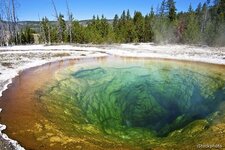DeepseekerADS
Gold Member
- Mar 3, 2013
- 14,880
- 21,733
- Detector(s) used
- CTX, Excal II, EQ800, Fisher 1260X, Tesoro Royal Sabre, Tejon, Garrett ADSIII, Carrot, Stealth 920iX, Keene A52
- Primary Interest:
- Other
Super Volcano is Bigger - KULR-8 Television, Billings, MT
Jul 08, 2014 8:08 PM EST
By Penny Preston
The world’s authority on Yellowstone’s Super Volcano says it’s more than twice as big as scientists once thought. Does that mean it’s more likely to blow up soon? Penny Preston found Dr. Robert Smith at his home near Grand Teton, and found the answer.
Millions of people visit Yellowstone each year to see its geysers, fumeroles, hot springs, and mud pots. It’s the largest concentration of thermal features in the world. The park sits on top of the world’s largest active volcano. The Super Volcano. Its most recent eruption was more than 600,000 years ago. All that remains is the top, or caldera.
When you come into the Park they’ll give you a map and it has an overlay of the caldera. It’s huge.
The scientist who knows more about the Super Volcano than anyone, Dr. Robert Smith of the University of Utah, said, “Anytime you come to Yellowstone you have to drive uphill. And the reason is this giant plume of magma, is very hot, therefore it’s bullient, low density and it just lifts the surface up.”
Dr. Smith has been studying Yellowstone’s earthquakes and it’s Super Volcanos for almost sixty years.
He pointed out, “And these giant eruptions, supervolcanos if you wish, probably last many, many months, maybe even years.”
Not only that, they’re huge, thousands of times larger than Mount St. Helens. Smith and his students use siesmographs to map the magma pool underneath Yellowstone’s volcano, and satellites to determine how much the land swells or bulges. They found that the magma is, “2.5 times larger than we had originally imaged.”
The magma movement is signaled by earthquakes. Smith mentioned the 4.8 magnitude Norris area earthquake that damaged Lake Hotel last spring.
He explained, “It’s the biggest earthquake in 30 years.”
So, how likely is it that the big one will blow soon?
“If we were to have another big eruption, it would affect a large area, on the order of several states. But, as I said, that probability is very, very, very, very small. In my calculations it’s point zero, zero, zero, one percent.”
Smith said the magma pool is not getting bigger. His team added a lot more seismographs over the years, and are getting a clearer picture of the magma
Jul 08, 2014 8:08 PM EST
By Penny Preston
The world’s authority on Yellowstone’s Super Volcano says it’s more than twice as big as scientists once thought. Does that mean it’s more likely to blow up soon? Penny Preston found Dr. Robert Smith at his home near Grand Teton, and found the answer.
Millions of people visit Yellowstone each year to see its geysers, fumeroles, hot springs, and mud pots. It’s the largest concentration of thermal features in the world. The park sits on top of the world’s largest active volcano. The Super Volcano. Its most recent eruption was more than 600,000 years ago. All that remains is the top, or caldera.
When you come into the Park they’ll give you a map and it has an overlay of the caldera. It’s huge.
The scientist who knows more about the Super Volcano than anyone, Dr. Robert Smith of the University of Utah, said, “Anytime you come to Yellowstone you have to drive uphill. And the reason is this giant plume of magma, is very hot, therefore it’s bullient, low density and it just lifts the surface up.”
Dr. Smith has been studying Yellowstone’s earthquakes and it’s Super Volcanos for almost sixty years.
He pointed out, “And these giant eruptions, supervolcanos if you wish, probably last many, many months, maybe even years.”
Not only that, they’re huge, thousands of times larger than Mount St. Helens. Smith and his students use siesmographs to map the magma pool underneath Yellowstone’s volcano, and satellites to determine how much the land swells or bulges. They found that the magma is, “2.5 times larger than we had originally imaged.”
The magma movement is signaled by earthquakes. Smith mentioned the 4.8 magnitude Norris area earthquake that damaged Lake Hotel last spring.
He explained, “It’s the biggest earthquake in 30 years.”
So, how likely is it that the big one will blow soon?
“If we were to have another big eruption, it would affect a large area, on the order of several states. But, as I said, that probability is very, very, very, very small. In my calculations it’s point zero, zero, zero, one percent.”
Smith said the magma pool is not getting bigger. His team added a lot more seismographs over the years, and are getting a clearer picture of the magma








